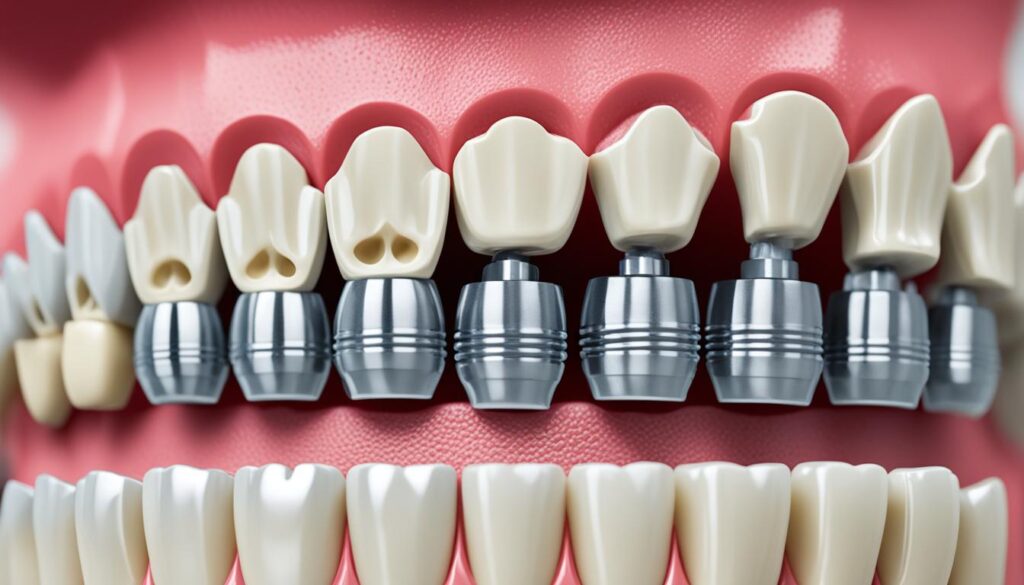When it comes to tooth replacement, endosteal implants are a revolutionary solution that offers both functionality and aesthetics. These dental implants are designed to mimic natural tooth roots and provide a strong foundation for replacement teeth.
Endosteal implants are placed directly into the jawbone through a surgical procedure. The implant then fuses with the bone over time, a process known as bone integration, ensuring stability and longevity. This integration not only enhances the strength of the jawbone but also prevents bone loss, a common issue after tooth loss.
One of the key advantages of endosteal implants is their versatility. They can be customized to meet the specific needs of each patient. Whether you require a single tooth replacement or multiple teeth, endosteal implants can provide a natural and seamless dental restoration.
With endosteal implants, adjacent teeth are not necessary for support, which minimizes the impact on neighboring healthy teeth. This makes endosteal implants an excellent choice for individuals with missing teeth who wish to restore their smile without compromising the integrity of their remaining teeth.
Furthermore, endosteal implants offer a long-lasting solution for tooth replacement. With proper care and maintenance, these implants can last up to fifteen years, providing a durable and reliable dental prosthetic.
Key Takeaways:
- Endosteal implants mimic natural tooth roots and provide a strong foundation for replacement teeth.
- They integrate with the jawbone, preventing bone loss and strengthening the jaw.
- Adjacent teeth are not required for support, preserving the integrity of healthy teeth.
- Endosteal implants are a long-lasting solution, lasting up to fifteen years with proper care.
- Consultation with a dentist or oral surgeon is necessary to determine eligibility for endosteal implants.
What Are Endosteal Implants?
Endosteal implants are dental grafts that mimic natural tooth roots and are placed directly into the jawbone. These implants serve as a sturdy foundation for dental prosthetics, such as crowns, bridges, or implant-supported dentures.
There are two main types of endosteal implants: blade implants and cylinder implants.
Blade Implants:
Blade implants consist of thin pieces of titanium that are used to anchor teeth when the jawbone has worn out or experienced significant bone loss. The blade design allows for secure attachment and stability even in compromised jawbone conditions.
Cylinder Implants:
Cylinder implants are the most common type of endosteal implants. They consist of a cylinder-shaped implant post that is surgically placed into the jawbone. A screw is then inserted into the cylinder, creating a stable foundation for the dental restoration. Cylinder implants are typically made of materials like titanium, ceramic, or zirconia and are topped with an abutment for attaching the artificial tooth.
Endosteal implants offer a durable and long-lasting solution for individuals looking to replace missing teeth. The choice between blade and cylinder implants depends on various factors such as jawbone condition, bone density, and individual needs. Your dentist or oral surgeon can help determine which type of endosteal implant is most suitable for you.
| Types of Endosteal Implants | Description |
|---|---|
| Blade Implants | Consist of thin pieces of titanium for anchoring teeth in compromised jawbone conditions. |
| Cylinder Implants | Most common type, featuring a cylinder-shaped implant post with a screw for stability, typically made of materials like titanium, ceramic, or zirconia. |
Benefits of Endosteal Implants
Endosteal implants offer several advantages for individuals seeking dental restoration and tooth replacement. These advanced dental implants not only improve the appearance of your smile but also provide long-term functional benefits. Here are some key benefits of endosteal implants:
1. Improved Speech
Endosteal implants can help restore proper speech patterns and clarity. Missing teeth or ill-fitting dentures can affect speech, causing slurring or mumbling. By replacing missing teeth with endosteal implants, you can regain your ability to speak clearly and confidently.
2. Youthful Look
Endosteal implants offer a natural and youthful appearance. They are designed to closely resemble your natural teeth in terms of shape, size, and color. The result is a rejuvenated smile and a more youthful appearance overall.
3. Reduced Fracture Risk
Endosteal implants play a crucial role in strengthening the jawbone. The integration of these implants with the jawbone helps stimulate bone growth, preventing bone loss and reducing the risk of fractures. This leads to improved oral health and a lower risk of dental complications in the long run.
4. Improved Ability to Chew
One of the primary functions of teeth is to enable efficient chewing. Endosteal implants restore the natural biting and chewing capabilities, allowing individuals to enjoy a wider range of foods and improve their overall nutrition.
5. Dental Restoration
Endosteal implants offer a comprehensive solution for dental restoration. Whether you need to replace a single missing tooth or multiple teeth, endosteal implants can provide a durable and long-lasting solution. They can be used to support dental prosthetics such as crowns, bridges, or implant-supported dentures, ensuring a stable and functional restoration.

| Benefits | Description |
|---|---|
| Improved Speech | Endosteal implants restore proper speech patterns and clarity. |
| Youthful Look | Endosteal implants offer a natural and youthful appearance. |
| Reduced Fracture Risk | Endosteal implants strengthen the jawbone, reducing the risk of fractures. |
| Improved Ability to Chew | Endosteal implants restore the natural biting and chewing capabilities. |
| Dental Restoration | Endosteal implants provide a comprehensive solution for dental restoration. |
How to Determine Eligibility for Endosteal Implants
Not everyone is eligible for endosteal implants. A consultation with a dentist or oral surgeon is necessary to determine candidacy. Factors such as good general health, a fully developed jawbone with enough alveoli bones, and healthy gum tissue are important. Individuals with gum diseases like gingivitis and those who use tobacco products may not be eligible. The healing process after surgery can take weeks or months.
Factors Affecting Eligibility
To be considered a suitable candidate for endosteal implants, several factors must be taken into account:
- Good general health: Candidates must have overall good health to ensure successful surgery and recovery.
- Fully developed jawbone: A fully developed jawbone is necessary to support the implant and ensure its stability.
- Healthy gum tissue: Healthy gums are vital for the success of the implant surgery. Diseased or unhealthy gums can hinder the healing process.
- Adequate alveolar bone: Sufficient alveolar bone is needed to support the implant and provide a stable foundation for the replacement tooth.
- Gum diseases and tobacco use: Individuals with gum diseases like gingivitis or those who use tobacco products may have compromised oral health, which can affect their candidacy for endosteal implants.
During the consultation, the dentist or oral surgeon will assess these factors to determine if the patient is a suitable candidate for endosteal implants. If the patient meets the eligibility criteria, the next steps for the implant procedure can be discussed.
Healing Process after Surgery
After the implant surgery, the healing process is crucial for the success of the procedure. It can take several weeks or months for the jawbone to fully heal and integrate with the implant. During this time, the patient should follow the dentist’s instructions for post-operative care, including maintaining good oral hygiene and avoiding activities that could disrupt the healing process. Regular follow-up appointments will be necessary to monitor the healing progress and ensure the implant’s stability.
| Factors | Eligibility |
|---|---|
| Good general health | Yes |
| Fully developed jawbone | Yes |
| Healthy gum tissue | Yes |
| Adequate alveolar bone | Yes |
| Gum diseases and tobacco use | No |
Conclusion
Endosteal implants are a popular and effective solution for tooth replacement. These dental implants offer a natural look and function, providing patients with a long-lasting and reliable dental prosthetic. One of the key advantages of endosteal implants is their ability to preserve the jawbone, improving oral health and preventing bone loss that can occur with missing teeth.
With proper care and maintenance, endosteal implants can provide patients with a beautiful and functional smile for a lifetime. Regular dental check-ups and daily oral hygiene practices are essential to ensure the longevity of the implants and the overall health of the mouth. Patients also have the option of choosing implant-supported dentures, which offer increased stability and comfort compared to traditional removable dentures.
Before undergoing endosteal implant placement, it is important to consult with a dental professional to determine eligibility for the procedure. Factors such as overall health, jawbone density, and gum tissue health play a crucial role in determining the suitability of endosteal implants. The dentist or oral surgeon will assess these factors to develop a personalized treatment plan that meets the specific needs and goals of each patient.
If you are considering tooth replacement options, consider the benefits of endosteal implants. These dental implants provide a permanent solution for tooth loss, offering improved aesthetics, function, and oral health. Schedule a consultation with your dental professional to explore the possibilities of endosteal implants and take the first step towards restoring your smile.
FAQ
What are endosteal implants?
Endosteal implants are dental grafts placed in the jawbone to act as artificial roots for replacement teeth.
What types of endosteal implants are available?
Endosteal implants come in blade and cylinder forms. Blade implants consist of thin pieces of titanium used for anchoring teeth when the jawbone wears out. Cylinder implants, on the other hand, are the most common type and consist of a cylinder and screw made of materials like ceramic and abutment.
What are the benefits of endosteal implants?
Endosteal implants offer numerous advantages such as not requiring adjacent teeth for installation, enhancing the smile, strengthening the jawbone, lasting up to fifteen years, minimizing discomfort, and having a high success rate. They can also prevent speech problems, maintain the alveolar bone, reduce the risk of fractures, and improve chewing ability.
How can I determine if I am eligible for endosteal implants?
Eligibility for endosteal implants depends on factors such as good general health, a fully developed jawbone with enough alveoli bones, and healthy gum tissue. Individuals with gum diseases like gingivitis and those who use tobacco products may not be eligible. A consultation with a dentist or oral surgeon is necessary to determine candidacy.
What is the conclusion about endosteal implants?
Endosteal implants are a popular and effective solution for tooth replacement. They offer numerous benefits, including a natural look and function, long-lasting results, preservation of the jawbone, improved oral health, and easy maintenance. However, eligibility for endosteal implants depends on factors like overall health, jawbone density, and gum tissue health. Consulting with a dental professional is crucial to determine the best treatment option for tooth replacement. With proper care, endosteal implants can provide a beautiful and functional smile for a lifetime.







